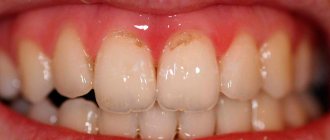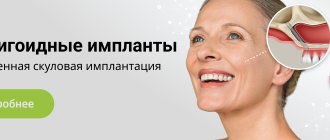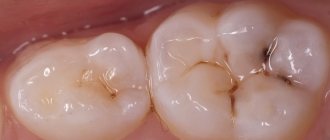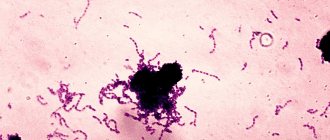Cervical caries, which occurs at or under the gum, is considered one of the most dangerous forms of caries. In the cervical area, tooth enamel is more vulnerable to cariogenic microbes, so pathology develops very quickly. In the article we will consider the features of the course and methods of treatment of cervical caries.
The structure of a tooth, when it comes to its structure, includes three main elements: the root, the neck and the crown. The first two are hidden by soft tissue. The enamel on them is thinner, and there are fewer minerals in it than on the visible part, so it is more vulnerable to cariogenic bacteria. Caries that develops in the area where the tooth comes into contact with the gums and under them is called cervical or root caries. It occurs mainly in adults over 30 years of age, and can appear on both the front and chewing teeth.
In this article
- Why does cervical caries occur?
- Stages of cervical caries
- How is cervical caries diagnosed?
- How to treat initial cervical caries
- How is advanced cervical caries treated?
- How to treat cervical caries on the front teeth
- What you can do at home
The problem with cervical caries is that it is almost asymptomatic until the third stage. The person does not complain of pain or discomfort, there is no visible destruction, and therefore treatment begins late. At the same time, basal caries progresses rapidly. The disease does not pose a serious danger if you visit the dentist every six months. People who rarely visit dental offices are at risk of losing a tooth. Let's talk about the causes and symptoms of cervical caries.
Why does cervical caries occur?
The main cause of any type of caries is damage to the enamel by cariogenic microorganisms from the group of streptococci. They live in the oral cavity of almost all people. Under certain conditions, microbes begin to actively multiply and secrete acids that corrode the enamel, washing away minerals from it. Demineralization of the enamel surface causes exposure of hard tooth tissues. Bacteria penetrate microcracks in dentin and form a carious cavity. Without treatment, it spreads and leads to gradual tooth decay. However, microbes alone are not enough for the development of caries. They are dangerous only in the presence of other factors for the occurrence of carious lesions. Among them:
- Insufficient oral hygiene. If you brush your teeth twice a day, use dental floss and irrigators for cleaning, then the risk of caries is quite low. Otherwise, deposits and food debris will accumulate in the interdental spaces and gum pockets. They are a favorable environment for the spread of microbes.
- Poor nutrition. Cariogenic bacteria feed on carbohydrates. Immediately after eating sweet foods, which contain a lot of fast carbohydrates, active proliferation of microbes begins. This process is accompanied by a sour taste in the mouth. The more sweets a person eats, the more often he develops tooth decay.
- Nicotine addiction. Smoking contributes to the formation of plaque on the enamel. Over time, it mineralizes and hardens, leading to the formation of tartar, which contains many bacteria. They may also be covered with plaque, as a result of which caries begins to develop between the enamel and tartar.
- Disorders of the salivary glands. Saliva not only washes away food debris and microbes from the oral cavity, but also neutralizes the waste products of cariogenic bacteria. Some diseases are accompanied by insufficient saliva production, which can become a factor in the development of caries.
- Enamel abrasion. The enamel surface protects the hard tissues of the tooth from external factors. Some people's enamel is very thin and tends to wear away, resulting in more tooth decay.
These are the main factors in the development of caries. But there are many other reasons, including weak immunity, mechanical injuries to teeth, hormonal imbalances, endocrine pathologies, etc. If they are not eliminated, the disease will periodically recur.
Why does a tooth rot under a crown?
The emergence of a pathological process occurs for a number of reasons. All of them are united by the same outcome - the penetration of pathological microorganisms. Among the most common causes of rotting are:
- Poor hygiene. If the patient does not keep his teeth clean and his oral cavity healthy, plaque accumulates on the teeth and tartar forms. These processes are accompanied by damage to the gums that protect the cervical part. The root of the tooth and the junction with the crown are exposed to destructive effects.
- Bad habits, unhealthy diet.
- Lack of calcium, bone tissue pathology.
- Secondary caries, decementation and food getting under the crown. Food rots, causing tooth decay.
Stages of cervical caries
Cervical caries develops according to the same scenario as other types of this disease, but much faster. Let us describe the stages of development of root caries:
- Initial (white spot stage). It is asymptomatic. A demineralized area of enamel forms in or under the gum area. It looks like a white or chalky spot. Gradually it begins to fade, but this is difficult to notice with the naked eye, especially if the pathology is localized on the back surface of the tooth or on the molars and premolars. If it starts under the gum, then it can only be detected using hardware diagnostics.
- Superficial. The carious spot becomes larger and acquires a yellowish or brownish tint. Destructive processes begin on the tooth surface. At this stage, the pathological focus has not yet spread to hard tissue. The patient may experience discomfort when eating sweet foods. It disappears immediately after the stimulus is removed. Often people attribute this symptom to increased sensitivity of the gums.
- Average. Damage to hard tissues is observed. A person experiences severe discomfort when eating sweet, sour, cold or hot foods. Possible pain. These signs disappear as soon as you brush your teeth.
- Deep. The last stage is an advanced form of the disease. Deep damage to dentin occurs. The pathological process involves the tooth root and pulp. The tooth may split into several parts or break in the neck area. The patient almost constantly experiences pain, which painkillers do not help eliminate.
Treatment for caries can vary depending on the degree of damage to the tooth. The method is selected individually after diagnosis.
Is it possible not to fill and not drill?
The leading expert of the Australian research group, Wendell Evans, believes that filling is an optional procedure: previously it was believed that when caries appears, you need to immediately drill a hole and install a filling to prevent further tooth destruction; however, tooth decay actually does not spread as quickly as dentists believe. On average, it may take from 4 to 8 years for caries to move from the initial stage of enamel destruction to the destruction of inner dentin.
According to scientists, it is necessary to drill in the case when there is already a hole in the tooth, i.e. its cavity is visible. Before this, local use of dental protective varnish is recommended - it will help in the early stages of caries development to slow down, or even completely prevent its development.
Dental research offers a variety of methods to prevent dental caries. For example, many years of research by dentist Wenyan Shi from the University of California made it possible to positively answer the question: is it possible to stop carious lesions with a simple rinse?
Late last year, Dr. Shi introduced a new mouthwash to American patients that almost completely destroys harmful streptococcal bacteria. These bacteria are the main cause of dental caries. They contribute to the formation of plaque on teeth, which in turn can also cause gum disease and erode enamel.
The new mouthwash contains special antimicrobial peptides that only affect bacteria that cause caries. This approach differs significantly from the action of various antibiotics, which kill all bacteria, both harmful and beneficial. Also, the use of such peptides makes it possible to develop a kind of protection against the formation of new plaque and tartar.
Despite the safety and effectiveness of this product, experts do not cancel traditional teeth brushing, since the likelihood of streptococci counteracting such peptides still remains. To further study this problem, dentist Wenyan Shi has already received a grant.
It is quite possible that such rinses will soon be recommended by dentists in Volgograd and Volzhsky. In the meantime, American patients have the opportunity to taste the peptides by purchasing special anti-caries lozenges.
Do not delay visiting the dentist; timely plaque removal and professional teeth cleaning will allow you to postpone the appearance of caries for a long time, which means the danger of tooth loss!
How is cervical caries diagnosed?
If the carious lesion is localized on the visible part of the tooth, the doctor makes a diagnosis after an external examination. But to confirm it, a special test is performed using a dye solution. It is applied to the enamel and left for 3-4 minutes. The affected area turns blue. After a few hours, the dye is completely washed out of the mouth.
The doctor may also prescribe an x-ray to assess the nature of the spread of caries, the depth of the carious cavity, the condition of the nerve endings, etc. Based on the results of the examination, a treatment method is selected. It is determined, first of all, by the stage of the disease.
What to give up from food to prevent tooth decay
If you like to eat a lot of sweets, then the issue of preventing tooth decay may be more difficult than it seems. Everyone knows that pathogenic microflora feels very comfortable when a person eats sweets. It is the excessive, regular consumption of buns, sweets, cakes, chocolate that not only spoils the figure, but also the teeth.
Regular consumption of fried, too spicy or salty foods also has an adverse effect on teeth. Too acidic also negatively affects tooth enamel. Gradually destroying its structure, promoting the development of caries.
Particular attention should be paid to the following products:
- Various greens;
- fresh vegetables;
- fresh fruits.
It is better to eat food that has been subjected to gentle heat treatment; eating apples, carrots and similar products is very useful. If you are a fan of canned foods, then keep in mind that marinades also have a bad effect on tooth enamel.
How to treat initial cervical caries
At the white spot stage, caries can be treated using therapeutic procedures. It is necessary to restore the enamel structure by saturating it with minerals. First, the dentist will clean the affected tooth from plaque and tartar, and then apply a solution containing fluoride, magnesium, phosphorus and calcium to it. Under the influence of the active components, the enamel is remineralized and the pathological process is blocked. The patient is also prescribed mouth rinses with an antiseptic solution and toothpaste with fluoride.
How to treat superficial caries
If the carious area has managed to destroy the enamel, but has not penetrated into the hard tissues, remineralization is carried out, as in the first stage. The dentist grinds the affected area of the tooth, removes damaged tissue and applies a solution to the enamel to restore it. Several procedures may be required - 5-10 sessions. Throughout the treatment, the patient uses medicated toothpaste.
Treatment of cervical caries at the middle stage
As a rule, people consult a doctor when root caries has reached the third stage. At this stage, tooth filling is required. The doctor removes the affected tissue, carries out antiseptic treatment of the carious cavity and fills it with filling material. The procedure is performed under local anesthesia.
Main symptoms and stages of the disease
There are several symptoms, the appearance of which should alert each of us. If they are detected, do not delay your visit to the dental clinic. The most common symptom of the onset of an irreversible process in tooth tissue is the accumulation of a large amount of yellow plaque and stone on the enamel.
It is also abnormal to have a strong and very unpleasant odor from the mouth, even with constant use of rinses and breath fresheners. Dark spots may appear on the enamel, and the teeth themselves may react sharply to exposure to hot or, conversely, very cold food or drinks.
If the above symptoms are ignored, dark spots may appear on the enamel, particularly near the neck of the tooth and even on the roots. The patient may complain of frequent pain, which is not relieved even by strong painkillers and radiates to the temples and the back of the head. Subsequently, the process of pulp death begins, the disease affects the nerve endings located inside the tooth, as a result of which the pain becomes simply unbearable and has a constant, aching character.
How is advanced cervical caries treated?
Deep caries is often accompanied by damage to the pulp, so depulpation is required. After this, root canal treatment and filling are performed. In some cases, nerve removal can be avoided. Then treatment is carried out according to the standard algorithm:
- Anesthesia.
- Removal of deposits and tartar.
- Selecting the shade of the future filling.
- Retraction of the gingival margin.
- Preparation of a carious cavity.
- Tooth isolation.
- Grinding.
- Filling.
- Polishing the filling.
The procedure can be more complicated if the carious lesion is located under the gum. It has to be cut to open access to the neck and root. After the main treatment, the doctor applies sutures, which dissolve within a few days.
If the patient goes to the doctor late and the tooth is almost completely destroyed, it is removed. The question arises about installing an implant.
Basic methods of dental restoration
Modern dentistry offers several solutions for restoring damaged teeth.
- Filling. If a premolar or molar is less than 50% destroyed, a filling can be placed. Carious cavities are cleaned and dried. Large fillings are installed on anchors or fiberglass pins.
- Prosthetics. If the tooth is severely damaged, it is treated, ground and a crown is installed - metal-ceramic, ceramic or zirconium dioxide. In case of deep caries, it may be necessary to clean the canals and install a stump tab to fix the crown.
If the natural tooth cannot be saved, it should be removed and an appointment for implantation should be made. You can place an implant with a temporary crown immediately after extraction. There is also a classic implantation option - an artificial structure is implanted 2-3 months after tooth extraction. It is important to know that after extraction of a molar or premolar, bone tissue rapidly decreases, so you should not delay implantation for long, since osteoplasty may be required after a year.
How to treat cervical caries on the front teeth
Cervical caries of the anterior teeth causes the most discomfort. Firstly, it develops and progresses faster than on molars and premolars. Secondly, the front teeth fall into the smile zone, so a cosmetic defect also occurs. Treatment is carried out according to the usual scheme, but the material for the filling is selected more carefully. It should not differ in color from the rest of the tooth, otherwise it will look unaesthetic. The cost of such a filling is significantly higher than the standard one.
What to do if the root remains in the gum?
Now you know why you should not leave the roots of decayed teeth in the gums, but sometimes situations arise when the presence of roots is not obvious: the patient is not bothered by anything, and he thinks that there is nothing left in the gums. This happens, for example, with an illiterate tooth extraction: as a result of the actions of an unqualified employee, the root or part of it remains in the soft tissues, and they find out about it too late. If you suspect that a tooth root remains in the gum, contact specialists who will conduct a thorough diagnosis. Signs indicating the possible presence of a tooth root include:
- frequent and significant pain even after a long period of time after visiting the surgeon,
- redness of the mucous membrane, bleeding,
- pulsation and painful sensations when pressing, chewing,
- heat.
If the answer to the question “can a decayed tooth be cured” is negative, it is removed, like the root. When it turns out that the root of the tooth, for one reason or another, remains in the gum, and its removal is required, the procedure is carried out as follows.
- First, the attending physician gives an injection of an anesthetic, which is necessary to ensure that the operation is completely painless.
- Then, after about 5-10 minutes, when the remedy has taken effect, the doctor makes an incision in the gum, and in severe cases, also makes a hole in the bone tissue using a drill.
- Having firmly grasped the root with forceps, the doctor removes it from the hole. Because some teeth may have multiple roots, they may require root division. This is done using a traditional burr or a modern method - ultrasound.
- Then the place that was subjected to such a traumatic procedure is treated with an antiseptic and a composition that accelerates healing. If there are incisions, stitches are applied.
If you are bothered by frequent pain in your jaw, although there are no apparent reasons for this, you should not hope that the pain will go away on its own. Contact qualified dentists at a specialized dental clinic, whose staff have many years of experience and will be able to find out the cause of the ailment. They will determine whether it is possible to restore a damaged tooth if the cause of the pain lies in it, and will do everything possible to save and restore the tooth, as well as quickly and painlessly remove it if there is no other option.
"AlfaDent" - we remove the problem at the root.
What you can do at home
We described the features of caries treatment at different stages in the dentist's office. Many people are interested in the question of what to do if the disease develops at home, whether it can be stopped on their own. The only thing available to the patient is prevention. If a carious lesion has already begun, it is impossible to reverse it with the help of rinses or folk remedies.
However, you can slow it down or stop it if you follow a number of simple rules:
- brush your teeth twice a day and rinse your mouth after eating;
- give up sweet foods and sodas;
- quit bad habits, in particular smoking;
- use irrigators to clean the oral cavity.
In addition, do not forget to check your teeth every six months, even if you are not worried about caries symptoms.
What else do you need to know?
- To maintain healthy teeth and gums, it is important to use a brush of medium hardness; the bristles should not scratch the enamel and mucous membrane or cause discomfort. It must be changed at least every 2 months, since pathogenic microorganisms accumulate on the bristles. You also need to replace the brush if it has lost its original shape.
- When using a toothpaste containing fluoride, you must not only brush your teeth for 2-3 minutes, but also not rinse your mouth for the same amount of time. During this period, the active components will penetrate the enamel, which will increase the effectiveness of remineralization.
- When choosing a toothpaste with fluoride, it is better to give preference to more expensive options, since they contain sodium aminofluorides. These substances are more effective than sodium monofluorophosphate, which is present in budget toothpastes. Saving in this case is impractical.
- Do not neglect mouth rinses. They contain sodium fluorides and aminofluorides, antiseptic and antibacterial components that prevent plaque formation and inhibit the growth and reproduction of cariogenic microbes. But you should also not overuse mouthwashes, since antiseptics can disrupt the composition of the microflora of the oral cavity, resulting in an unpleasant odor.
Remember that caries prevention will be effective only with an integrated approach and regular visits to the dentist. It is better to make sure once again that your teeth are healthy than to treat the consequences of a negligent attitude towards yourself.
| Author of the article: | Gasparyan Eliza Arturovna |
| Speciality: | Dentist-therapist, dentist-endodontist |
| Experience: | 10 years |
Make an appointment










